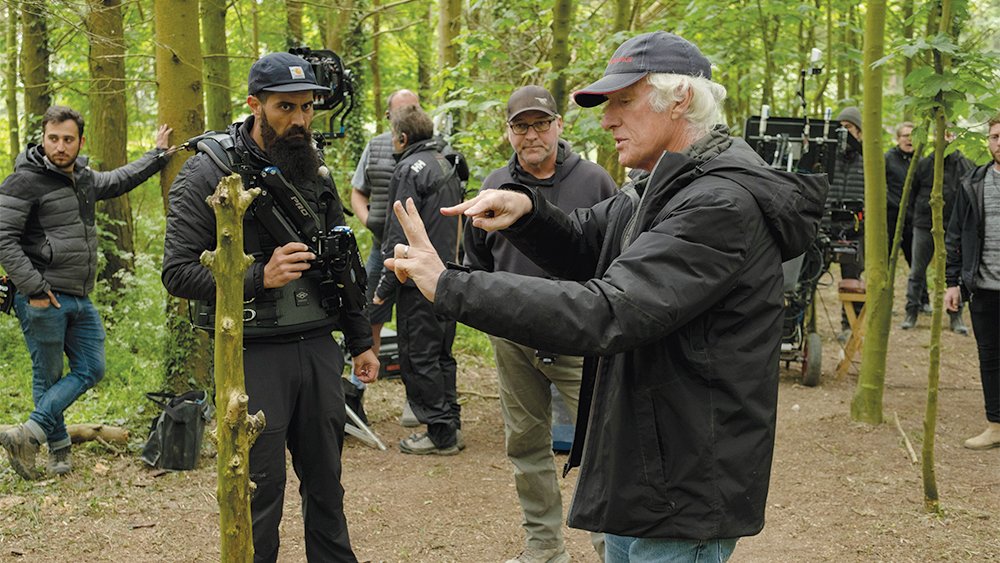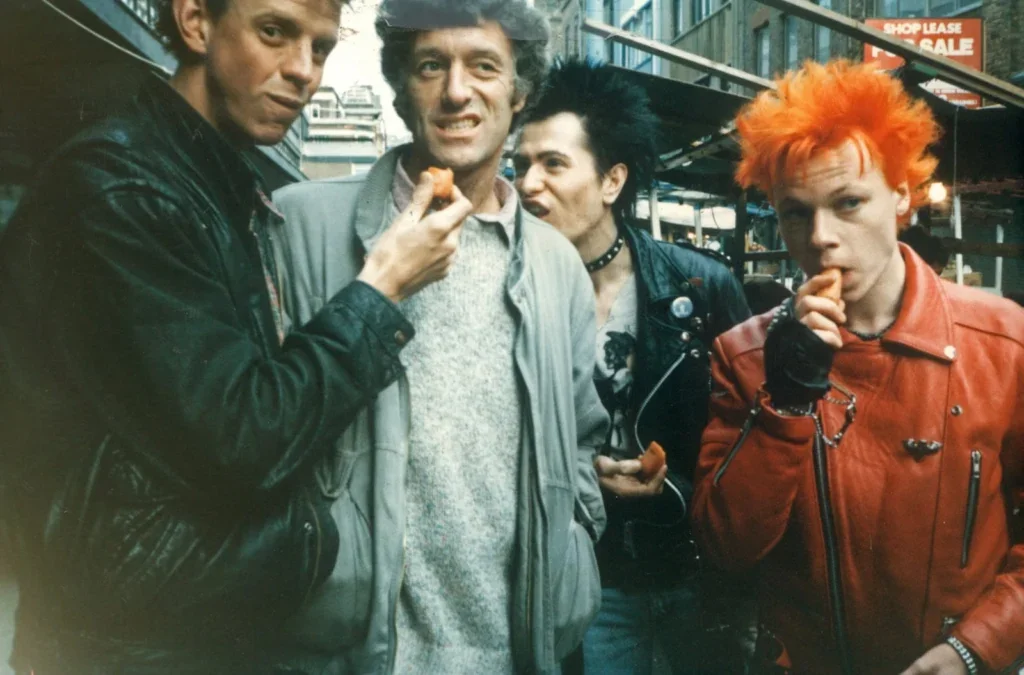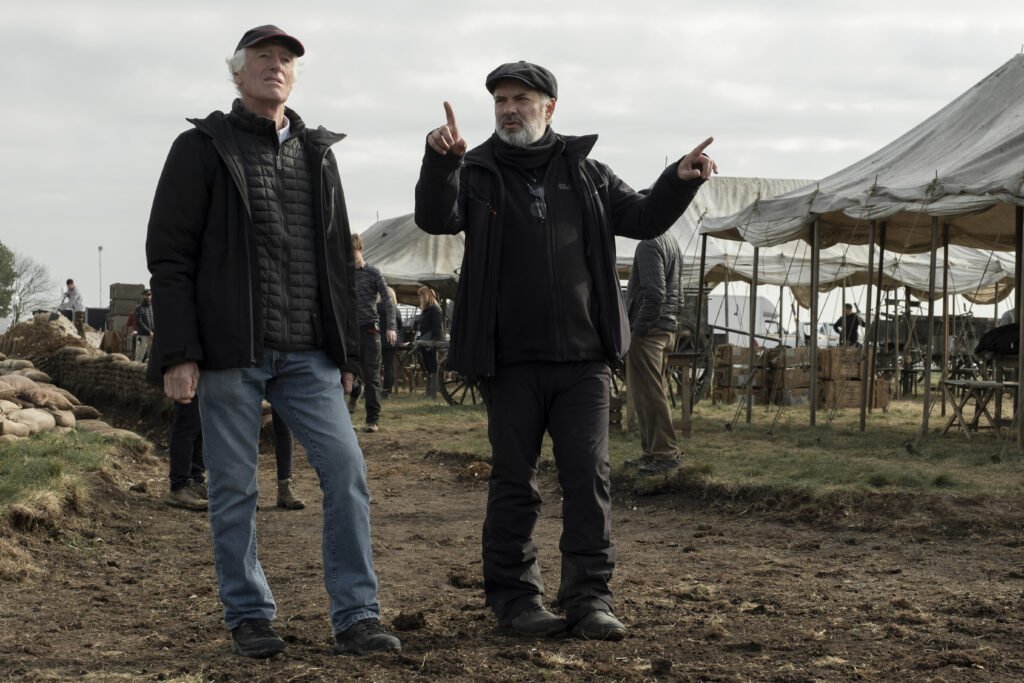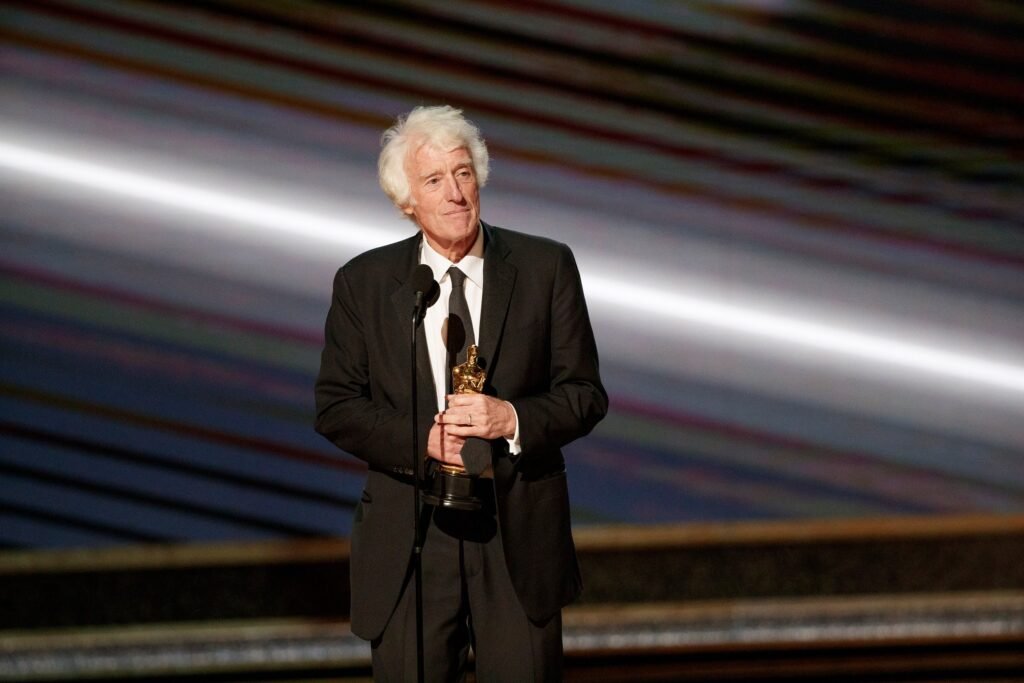Roger Deakins Cinematography: In the pantheon of great cinematographers, few names shine as brightly as that of Roger Deakins. Born on May 24, 1949, in the charming coastal town of Torquay, Devon, England, Deakins has risen to become one of the most influential and iconic figures in the world of cinema. With a career spanning over five decades and a filmography that includes collaborations with some of the most renowned directors in the industry, such as the Coen brothers, Sam Mendes, and Denis Villeneuve, Deakins has left an indelible mark on the art of filmmaking, redefining the very essence of visual storytelling.

Table of Contents
Early Life and Education: The Genesis of a Visionary
Roger Deakins’ journey as a cinematographer began long before he ever stepped behind a camera. Growing up in a household that valued creativity and artistic expression, Deakins was exposed to the world of art and design from a young age. His father, a construction company owner, and his mother, an actress and amateur painter, fostered an environment that nurtured his innate curiosity and encouraged him to explore his artistic inclinations.
Deakins’ formal education began at Torquay Boys’ Grammar School, where he excelled in his studies and developed a keen interest in the visual arts. However, it was during his time at the Bath Academy of Art, where he studied graphic design, that Deakins truly discovered his passion for photography. Armed with a camera and an insatiable desire to capture the world around him, Deakins spent countless hours honing his skills, developing an eye for composition and lighting, and learning to manipulate the interplay of light and shadow to create stunning visual narratives.
Despite his talent and dedication, Deakins faced his first major setback when his application to the National Film School was rejected, with the institution citing that his photography was not “filmic” enough. Undeterred by this rejection, Deakins embarked on a year-long journey through the rural landscapes of North Devon, documenting the lives of its inhabitants through his lens. This experience not only sharpened his photographic skills but also deepened his understanding of the power of visual storytelling, laying the foundation for his eventual admission to the National Film School in 1972.

Early Career and Breakthrough: Illuminating the Silver Screen
Upon graduating from the National Film School, Deakins began his career in the film industry, working on a diverse range of projects that showcased his versatility as a cinematographer. His early work included documentaries that took him to far-flung corners of the world, from the high seas of the Whitbread Round the World Yacht Race to the dusty plains of East Africa. These experiences allowed Deakins to refine his craft, developing a keen eye for detail and a mastery of light that would become the hallmarks of his distinctive visual style.
Deakins’ breakthrough in the world of feature films came in the early 1980s, as he began to collaborate with a new generation of directors who were eager to push the boundaries of cinematic storytelling. His work on “The Shawshank Redemption” (1994), directed by Frank Darabont, marked a turning point in his career, showcasing his ability to use natural lighting and wide shots to convey the passage of time and the oppressive nature of prison life. The film’s critical and commercial success cemented Deakins’ reputation as a cinematographer of exceptional talent and vision, paving the way for a series of collaborations that would redefine the art of filmmaking.

Collaborations and Iconic Films: A Symphony of Light and Shadow
Throughout his illustrious career, Roger Deakins has forged enduring partnerships with some of the most visionary directors in the film industry, creating a body of work that stands as a testament to the power of collaboration and the transformative potential of cinema.
The Coen Brothers: A Partnership Forged in Light One of Deakins’ most significant and long-standing collaborations has been with the Coen brothers, a partnership that has yielded some of the most visually stunning and thematically rich films of the past three decades. From the snow-swept vistas of “Fargo” (1996) to the sepia-toned period piece “O Brother, Where Art Thou?” (2000), Deakins’ work with the Coen brothers has consistently pushed the boundaries of what is possible with the camera, creating images that are at once beautiful and haunting, poetic and visceral.
Their collaboration reached its apex with “No Country for Old Men” (2007), a neo-western thriller that showcased Deakins’ mastery of light and shadow, creating a sense of unease and foreboding that perfectly complemented the film’s themes of violence and moral ambiguity. The film’s critical and commercial success earned Deakins his first Academy Award nomination for Best Cinematography, cementing his status as one of the most innovative and influential cinematographers of his generation.
Denis Villeneuve: Crafting Worlds of Wonder Another significant collaboration in Deakins’ career has been with director Denis Villeneuve, with whom he has worked on three critically acclaimed films: “Prisoners” (2013), “Sicario” (2015), and “Blade Runner 2049” (2017). Deakins’ work on “Blade Runner 2049,” in particular, has been hailed as a masterclass in cinematography, with his stunning use of color, composition, and lighting bringing the dystopian world of the film to life in breathtaking detail.
The film’s visual splendor, achieved through a combination of Roger Deakins Cinematography and the film’s production design, earned Deakins his first Academy Award for Best Cinematography, a long-overdue recognition of his immense contributions to the art form. Deakins’ collaboration with Villeneuve showcases his ability to create immersive, atmospheric worlds that transport viewers to another time and place, cementing his status as a true master of his craft.

Sam Mendes: Reinventing the Language of Cinema Deakins’ collaborations with director Sam Mendes have also yielded some of the most visually striking films of the past two decades. Their work on “Jarhead” (2005), “Revolutionary Road” (2008), and “Skyfall” (2012) demonstrated Deakins’ ability to craft compelling visual narratives that enhance the emotional depth of the story being told.
However, it was their collaboration on the war epic “1917” (2019) that truly showcased the extent of Deakins’ technical prowess and innovative spirit. The film, which appears to unfold in a single, uninterrupted shot, required meticulous planning and execution, with Deakins utilizing a combination of long takes, elaborate camera movements, and seamless digital stitching to create a sense of unbroken immersion in the story. The result was a cinematic achievement that earned Deakins his second Academy Award for Best Cinematography, further solidifying his place among the greats of his profession.

Other Notable Works: A Tapestry of Visual Storytelling Beyond his collaborations with the Coen brothers, Villeneuve, and Mendes, Deakins has lent his unique visual style to a wide range of films throughout his career. His work on Martin McDonagh’s “In Bruges” (2008) showcased his ability to capture the beauty and complexity of a European cityscape, while his collaboration with director Andrew Dominik on “The Assassination of Jesse James by the Coward Robert Ford” (2007) demonstrated his mastery of the western genre, with sprawling vistas and intimate character moments captured in equal measure.
Deakins’ work on “Kundun” (1997), directed by Martin Scorsese, showcased his ability to adapt his visual style to suit the demands of a historical epic, while his contributions to “A Beautiful Mind” (2001) and “The Reader” (2008) demonstrated his versatility in capturing the nuances of human emotion on screen. Each of these films stands as a testament to Deakins’ ability to weave a tapestry of visual storytelling, creating images that linger long after the final credits have rolled.
Signature Style and Techniques: The Art of Seeing
At the heart of Roger Deakins’ distinctive visual style lies a deep understanding of the art of seeing, a mastery of light, shadow, and composition that imbues each frame with a sense of emotional resonance and narrative depth. Roger Deakins Cinematography is rooted in a belief that the camera should serve the story, rather than drawing attention to itself, and as such, he often employs a minimalist aesthetic that allows the viewer to focus on the characters and their journey.
One of Deakins’ signature techniques is his use of natural light, which he often manipulates to create a sense of depth and texture within the frame. Whether it’s the warm glow of a setting sun filtering through a window or the harsh glare of a desert landscape, Deakins has a keen eye for the subtle interplay of light and shadow, creating images that are both visually striking and emotionally resonant. His use of wide-angle lenses and deep focus also allows him to create a sense of space and depth within the frame, immersing the viewer in the world of the film.
Another hallmark of Deakins’ style is his attention to composition, with each frame carefully constructed to guide the viewer’s eye and convey the emotional subtext of the scene. He often employs a combination of static shots and fluid camera movements, using the camera to mirror the emotional state of the characters or to create a sense of visual tension. Whether it’s the claustrophobic corridors of a prison in “The Shawshank Redemption” or the sprawling vistas of the American West in “True Grit,” Deakins’ compositions are always in service of the story, creating a visual language that speaks volumes without uttering a word.
In addition to his mastery of traditional cinematographic techniques, Deakins is also known for his willingness to experiment with new technologies and techniques in service of the story. His pioneering use of digital cinematography on films like “In Time” (2011) demonstrated his ability to embrace new tools and adapt his visual style to suit the needs of the project. Similarly, his use of practical effects and miniatures on films like “Blade Runner 2049” (2017) showcased his commitment to creating a sense of tangible reality on screen, even in the most fantastical of settings.
Legacy and Influence of Roger Deakins Cinematography: Illuminating the Future of Cinema

Roger Deakins’ contributions to the art of cinematography have left an indelible mark on the film industry, setting a new standard for visual storytelling and inspiring a generation of filmmakers to push the boundaries of what is possible with the camera. His work has become synonymous with excellence in cinematography, earning him countless accolades and awards, including 15 Academy Award nominations for Best Cinematography and two wins for “Blade Runner 2049” and “1917”.
Beyond his individual achievements, however, Deakins’ legacy extends to the countless cinematographers and filmmakers who have been inspired by his work and have sought to follow in his footsteps. His collaborations with directors like the Coen brothers, Denis Villeneuve, and Sam Mendes have resulted in some of the most visually stunning and emotionally resonant films of the past three decades, cementing his status as one of the greatest cinematographers of all time.
Deakins’ influence can be seen in the work of countless cinematographers working today, many of whom have cited him as a major inspiration and influence on their own artistic development. His willingness to experiment with new technologies and techniques, his commitment to serving the story above all else, and his ability to create images that are both beautiful and meaningful have become the hallmarks of a new generation of cinematographers who are pushing the boundaries of what is possible with the camera.
In addition to his work behind the camera, Deakins has also made significant contributions to the film community through his teaching and mentorship. He has served as a mentor to countless aspiring cinematographers, sharing his knowledge and expertise through workshops, seminars, and one-on-one instruction. His dedication to the craft of cinematography and his willingness to share his insights and experiences with others have made him a beloved figure in the film community, and his influence will continue to be felt for generations to come.
Deakins’ impact on the film industry extends beyond his work as a cinematographer. He has also been a vocal advocate for the importance of visual storytelling in cinema, emphasizing the role of the cinematographer in creating meaning and emotion through the use of light, shadow, and composition. His philosophy of cinematography, which prioritizes simplicity, authenticity, and emotional resonance, has become a guiding principle for many young filmmakers who seek to create work that is both visually striking and thematically rich.
Moreover, Deakins’ collaborations with directors like the Coen brothers and Denis Villeneuve have helped to redefine the relationship between cinematography and directing, demonstrating the power of a strong creative partnership in bringing a shared vision to life on screen. Through his work, Roger Deakins Cinematography is not merely a technical craft but a vital component of the storytelling process, one that can elevate a film from the realm of the ordinary to the extraordinary.
Deakins’ legacy also extends beyond the world of film and into the realm of popular culture. His distinctive visual style and iconic imagery have become a touchstone for a generation of filmgoers, influencing everything from fashion and photography to graphic design and video game aesthetics. The stark, minimalist landscapes of “No Country for Old Men,” the neon-soaked cityscapes of “Blade Runner 2049,” and the hauntingly beautiful vistas of “1917” have all become part of the cultural lexicon, inspiring countless imitations and homages across a wide range of media.
Perhaps most importantly, however, Deakins’ work has helped to elevate the art of cinematography in the public consciousness, bringing renewed attention to the vital role that visual storytelling plays in the medium of film. Through his collaborations with some of the most acclaimed directors of our time, his willingness to take risks and experiment with new techniques, and his unwavering commitment to emotional truth and authenticity, Deakins has shown that cinematography is not merely a technical skill but a powerful tool for exploring the human condition and illuminating the world around us.
Conclusion
In the end, Roger Deakins’ legacy is one of a visionary cinematographer who has redefined the art of visual storytelling, creating images that are at once beautiful, haunting, and deeply moving. Through his collaborations with some of the most talented directors of our time, his willingness to experiment with new technologies and techniques, and his unwavering commitment to serving the story above all else, Deakins has left an indelible mark on the film industry, inspiring a new generation of filmmakers to push the boundaries of what is possible with the camera.
As we look to the future of cinema, it is clear that Deakins’ influence will continue to be felt for years to come. His work has become a touchstone for excellence in cinematography, a standard against which all other cinematographers will be measured. And while the tools and technologies of filmmaking may continue to evolve and change, the core principles that Deakins has embodied throughout his career – a deep understanding of the art of seeing, a commitment to serving the story, and a willingness to take risks and experiment – will remain as relevant and important as ever.
Roger Deakins’ is not just one of a great cinematographer but of a true artist who has used the power of the camera to illuminate the human condition, to tell stories that move us, inspire us, and challenge us to see the world in new and different ways. And for that, we owe him a debt of gratitude that can never be fully repaid.
Roger Deakins Filmography
- Empire of Light (2022)
- 1917 (2019)
- The Goldfinch (2019)
- Blade Runner 2049 (2017)
- Hail, Caesar! (2016)
- Sicario (2015)
- Unbroken (2014)
- Prisoners (2013)
- Skyfall (2012)
- In Time (2011)
- Rango (2011)
- True Grit (2010)
- The Company Men (2010)
- A Serious Man (2009)
- Revolutionary Road (2008)
- The Reader (2008)
- Doubt (2008)
- The Assassination of Jesse James by the Coward Robert Ford (2007)
- In the Valley of Elah (2007)
- No Country for Old Men (2007)
- Jarhead (2005)
- The Village (2004)
- The Ladykillers (2004)
- House of Sand and Fog (2003)
- Intolerable Cruelty (2003)
- Levity (2003)
- A Beautiful Mind (2001)
- Dinner with Friends (2001)
- The Man Who Wasn’t There (2001)
- O Brother, Where Art Thou? (2000)
- The Hurricane (1999)
- Anywhere But Here (1999)
- The Siege (1998)
- The Big Lebowski (1998)
- Kundun (1997)
- Courage Under Fire (1996)
- Fargo (1996)
- Dead Man Walking (1995)
- The Shawshank Redemption (1994)
- The Hudsucker Proxy (1994)
- The Secret Garden (1993)
- Passion Fish (1992)
- Thunderheart (1992)
- Homicide (1991)
- Barton Fink (1991)
- The Long Walk Home (1990)
- Air America (1990)
- Mountains of the Moon (1990)
- La donna della luna (1988)
- Pascali’s Island (1988)
- Stormy Monday (1988)
- New Order: Touched by the Hand of God (1987)
- White Mischief (1987)
- The Kitchen Toto (1987)
- Personal Services (1987)
- Sid and Nancy (1986)
- Eric Clapton: Forever Man (1985)
- Defense of the Realm (1985)
- Shadey (1985)
- Level 42: Something About You (1985)
- The Innocent (1985)
- Return to Waterloo (1984)
- 1984 (1984)
- The House (1984)
- The Cinema of Stephen Dwoskin (1984)
- Herbie Hancock: Rockit (1983)
- Alan Bush: A Life (1983)
- Status Quo: A Mess of Blues (1983)
- Another Time, Another Place (1983)
- Marvin Gaye: Sexual Healing (1982)
- Worlds Apart (1980-1982)
- Towers of Babel (1981)
- Years of Lightning (1981)
- Wolcott (1981)
- Van Morrison in Ireland (1980)
- Lene Lovich: It’s You, Only You (Mein Schmerz) (1980)
- Box On (1980)
- Blue Suede Shoes (1980)
- Just for Today (1980)
- Champions (1979)
- Steppin’ Out (1979)
- Chimurenga – The War in Zimbabwe (1978)
- Bad Loser (1977)
- Empty Hand (1977)
- Before Hindsight (1977)
- Marquis de Sade’s Justine (1977)
- Welcome to Britain (1976)
- Mothers Own (1975)
What distinguishes Roger Deakins approach to cinematography?
Roger Deakins masterfully wields his camera to bolster the narrative, employing a clear and captivating approach. His cinematography often features the strategic use of wide-angle lenses, which allows him to envelop characters within their settings, using the backdrop as a canvas to further the unfolding of their stories.
Could Roger Deakins be considered one of the best cinematographers in history?
Indeed, Roger Deakins is celebrated as one of the most distinguished cinematographers in the industry. His illustrious career is marked by two Academy Award victories and an impressive sixteen nominations, underscoring his exceptional talent and influence in over seventy feature films.
What unique qualities does Roger Deakins bring to his cinematography work?
Known for his unique approach to lighting and color, Roger Deakins skillfully manipulates these elements to stir emotional responses. In ‘The Shawshank Redemption,’ his use of natural light symbolizes hope and freedom, while in ‘Sicario,’ minimal lighting is strategically employed to create an atmosphere of tension and unease. His artful use of color further defines his signature cinematographic style.
What is a cinematography masterclass, and who is it for?
A cinematography masterclass, like those provided by the American Society of Cinematographers, serves as an advanced educational platform for cinematographers seeking to refine their skills. These masterclasses offer practical demonstrations in lighting and camera techniques, insights into modern workflow practices, and in-depth analysis of feature films, all designed to deliver a holistic educational experience.